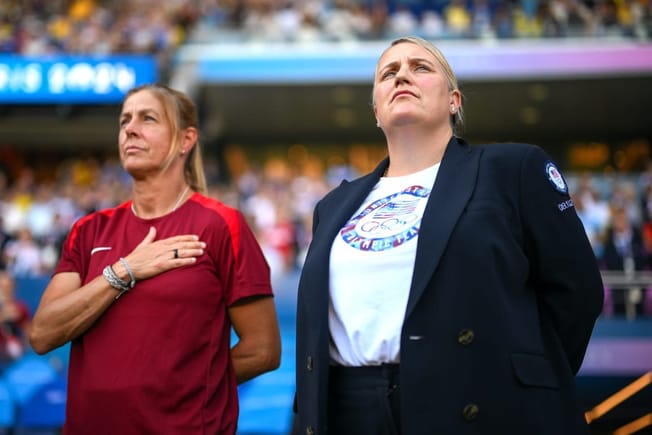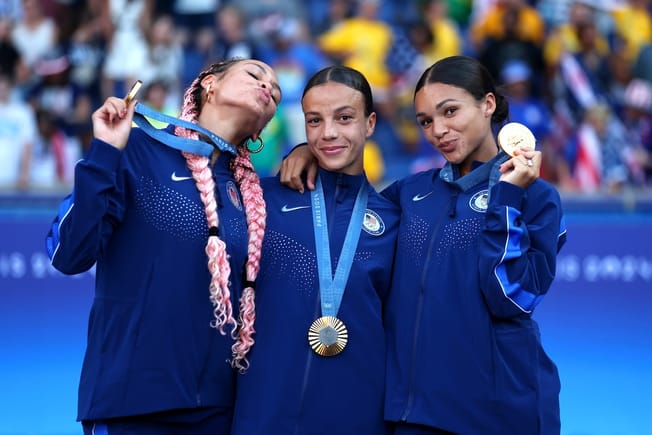The United States women’s national team beat Costa Rica 3-0 on Thursday to advance to the final of the Concacaf W Championship. It took some time to break down the Costa Rican defense, but both the scoreline and stats-sheet indicate that the USWNT had control of the game from the start.
A STRONG TRIO
Costa Rica lined up in a 5-4-1 and sat in a defensive block inside their own half, but the U.S.’s relentless counter pressing allowed the team to find space in the attacking third. The United States made nearly 100 more passes than their opponents in the final third and also had 12 of their 15 total shots come from inside the box.
Much of the USWNT’s success stemmed from the work of Rose Lavelle, Sophia Smith, and Mallory Pugh. That’s been true for the majority of this tournament so far.
In the group stage, Lavelle and Smith tallied goals against Jamaica and Pugh contributed two assists, one each against Jamaica and Haiti. On Thursday against Costa Rica, the trio delivered an impressive goal in first half stoppage time.
.@roselavelle’s 6th assist of 2022 and @MalPugh’s 6th goal of 2022 have us up 2-0 at the break!
— U.S. Women's National Soccer Team (@USWNT) July 14, 2022
🇺🇸🇺🇸🇺🇸🇺🇸🇺🇸🇺🇸🇺🇸🇺🇸🇺🇸🇺🇸🇺🇸 pic.twitter.com/mdITRUadt4
Lavelle played a cheeky backheel through to Pugh, who put away her first goal of the tournament. That goal doesn’t happen, though, without Smith’s defensive work to win the ball back from Costa Rica after a poor clearance. All three players involved in that goal also led the team in recoveries last night, which shows how valuable they are for the U.S. on both sides of the ball (data courtesy of StatsPerform).
HEAVY ROTATION
We could go on to talk about the U.S.’s other two goals – Emily Sonnett with the first and Ashley Sanchez with the third – but one other thing that stood out from this game is head coach Vlatko Andonovski’s approach to player rotation.
The starting lineup against Costa Rica included four changes from the 11 that started the final group stage game against Mexico. The United States also made five changes to their lineup from their tournament opener against Haiti to game two against Jamaica and another seven changes from Jamaica to the Mexico game. The only two players who have started every game for the U.S. at this tournament are Smith and Lindsey Horan. Andonovski has even rotated his goalkeepers, with Casey Murphy and Alyssa Naeher going back-and-forth in net.
Andonovski and the U.S. might be playing the long-game here, providing young players with starts, caps, and experience in a major tournament ahead of next year’s Women’s World Cup. But at what point does all this rotation hurt the on-the-field product?
In the post-game mixed zone, when asked about the team’s progression throughout the tournament, Alex Morgan said that Andonovski has the U.S. play in a slightly different way each game depending on the opponent’s approach. She went on to mention that it’s important for players to know their roles, since they change “from game to game”.
Some continuity could really help this U.S. team.
Even though they’ve secured four wins and four clean sheets in four games, they’ve been inconsistent. Some of the struggles against Haiti and the dip in performance from the Jamaica to Mexico games put that on full display. Andonovski also pointed out that his team made many technical errors against Costa Rica, and speculated whether it was a result of the stress and pressure associated with a knock-out game.
#USWNT Vlatko Andonovski - We made too many technical errors, too many for the players on the field because we know they are technical and can execute even under a lot more pressure. Today, for some reason, we made a little too many, that's something we're going to look into
— Taylor Vincent (@tayvincent6) July 15, 2022
I can’t help but wonder, though, if some of that stress might arise from players having to learn roles that change each game while playing with different teammates.
There won’t be enough time in this tournament to address all the hitches that Andonovski and Co. highlighted on Thursday night, as the U.S. is set to face Canada in the championship match on Monday.
With a trophy and a spot at the 2024 Olympics on the line, fielding a familiar line-up and focusing on that counter press might mitigate some of the United States’ inconsistency and help them secure the win over their North American rivals.







Comments